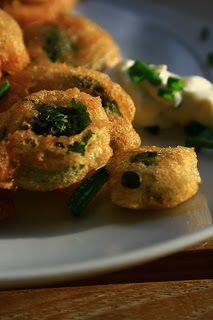
Another sure sign of spring is asparagus. Asparagus is available year round in the supermarket but in New England you will find the locally grown variety from late May to early June. Green asparagus is a great source of folic acid, with just ¼ cup providing one-third of the recommended daily intake.
When shopping for asparagus, whether in the supermarket or the farmer’s market, look for spears that snap, don't bend, and have nice, tight heads that are brightly colored. You may notice that some spears are plump, while others are skinny. The thicker stalks tend to be more tender while the thinner ones tend to be more flavorful. Obviously, the thicker the asparagus, the longer it will take to cook, so adjust any recipes accordingly. One isn't better than the other; it just depends which you prefer.
Once you bring the asparagus home, keep it fresh in the fridge for up to a week. Simply stand the stalks up in a glass with an inch or two of water in the bottom. To prepare asparagus, grasp each spear and bend it until it snaps. The spear will break at the natural point where it becomes tender. Asparagus is wonderful roasted or grilled (thicker variety works best for this) or lightly steamed and made into a soup. Try it with stir-fries or have it raw as a crudité.
The recipe below combines asparagus with spring onions. Spring onions are, as the name highlights, largely available in the spring. They are simply young regular onions that farmers pull from the field to thin the rows. You can differentiate them from scallions by their slight bulge near the root. They have a milder flavor than mature regular onions and are sweeter than scallions. They can be cooked and used as standard onions or leeks; better yet, maximize their tender, sweet flavor by using them raw in salads, salsas, and as a garnish. For this recipe I have caramelized them making their flavor even sweeter.
Asparagus and Caramelized Spring Onion Quiche
1 pie shell (home-ma de or store-bought)
de or store-bought)
½ tablespoon butter
1 cup spring onions, sliced (white part only – you can reserve the green part to use for stock)
1 ½ cups asparagus, chopped
6 eggs
¼ cup light cream
1 tablespoon chopped mint
Salt and pepper to taste
½ cup shredded sharp Vermont cheddar
Preheat oven to 375 degrees
Press the prepared pie dough into 9 inch pie dish. Set aside in the refrigerator as you prepare the quiche.
In a small sauté pan, melt butter over medium heat. Add sliced onion and sauté, stirring occasionally until onions begin to soften and turn brown – about 10 -15 minutes. Add chopped asparagus to pan and cook for an additional 2-3 minutes. Remove pan from heat and allow mixture to cool before adding to prepared pie shell.
In a medium bowl whisk together eggs and light cream. Add in the chopped mint and season with salt and pepper. Pour the egg mixture over the onion and asparagus mixture in the pie shell. Sprinkle the shredded cheese over the top.
Put the pie dish on a sheet pan and place in the oven. Bake until golden brown, and the egg mixture has set, 35 to 40 minutes. Be sure to rotate the quiche after 15 to 20 minutes to ensure even browning.













